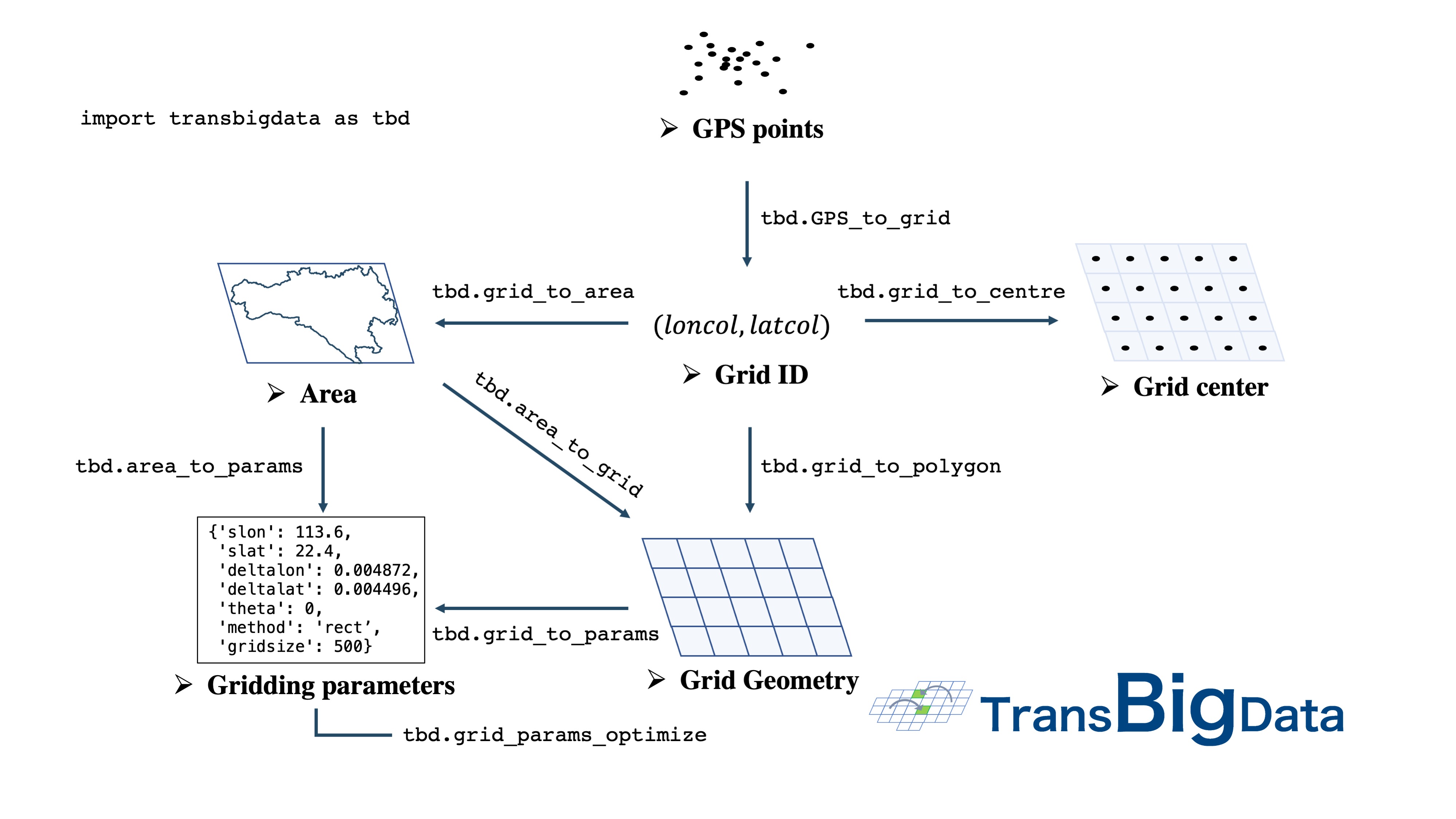数据栅格化
|
在边界或形状中生成矩形栅格 |
|
生成栅格化参数 |
|
将 GPS 数据与栅格匹配。 |
|
栅格的中心位置。 |
|
根据栅格ID生成几何列。 |
|
输入格网 ID 两列、地理面和格网参数。 |
|
从栅格重新生成栅格化参数。 |
|
优化栅格参数 |
|
输入经纬度和精度,编码geohash码 |
|
解码geohash码 |
|
输入geohash码生成geohash栅格单元格 |
栅格化框架

- transbigdata.area_to_grid(location, accuracy=500, method='rect', params='auto')
在边界或形状中生成矩形栅格
- 参数:
location (bounds(List) or shape(GeoDataFrame)) – 生成栅格的位置。如果边界为 [lon1, lat1, lon2, lat2](WGS84),其中 lon1 , lat1 是左下角坐标,lon2 , lat2 是右上角坐标 如果是形状,则应为 GeoDataFrame
accuracy (number) – 栅格尺寸(米)
method (str) – 直角、三角或六角
params (list or dict) – 栅格化参数。有关栅格化参数的详细信息,请参阅 https://transbigdata.readthedocs.io/en/latest/grids.html。给出格网参数时,将不使用精度。
- 返回:
grid (GeoDataFrame) – Grid GeoDataFrame、LONCOL 和 LATCOL 是栅格的索引,HBLON 和 HBLAT 是栅格的中心
参数 (列表或字典) – 栅格参数。有关栅格化参数的详细信息,请参阅 https://transbigdata.readthedocs.io/en/latest/grids.html。
- transbigdata.area_to_params(location, accuracy=500, method='rect')
生成栅格化参数
- 参数:
location (bounds(List) or shape(GeoDataFrame)) – 生成栅格的位置。如果边界为 [lon1, lat1, lon2, lat2](WGS84),其中 lon1 , lat1 是左下角坐标,lon2 , lat2 是右上角坐标 如果是形状,则应为 GeoDataFrame
accuracy (number) – 栅格尺寸(米)
method (str) – 直角、三角或六角
- 返回:
参数 – 栅格参数。有关栅格化参数的详细信息,请参阅 https://transbigdata.readthedocs.io/en/latest/grids.html。
- 返回类型:
list or dict
- transbigdata.GPS_to_grid(lon, lat, params)
将 GPS 数据与栅格匹配。输入是经度、纬度和格网参数列。输出是栅格 ID。
- 参数:
lon (Series) – 经度栏
lat (Series) – 纬度栏
params (list or dict) – 栅格化参数。有关栅格化参数的详细信息,请参阅 https://transbigdata.readthedocs.io/en/latest/grids.html。
- 返回:
矩形栅格
[LONCOL,LATCOL] (list) – 两列 LONCOL 和 LATCOL 一起可以指定栅格。
三角形和六边形栅格
[loncol_1,loncol_2,loncol_3] (list) – 栅格纬度的索引。两列 LONCOL 和 LATCOL 一起可以指定一个栅格。
- transbigdata.grid_to_centre(gridid, params)
栅格的中心位置。输入是格网ID和参数,输出是格网中心位置。
- 参数:
gridid (list) – 如果“矩形栅格”[LONCOL,LATCOL]:系列 两列 LONCOL 和 LATCOL 一起可以指定栅格。 如果“三角形和六边形栅格” [loncol_1,loncol_2,loncol_3] :系列 栅格纬度的索引。两列 LONCOL 和 LATCOL 一起可以指定一个栅格。
params (list or dict) – 栅格化参数。有关栅格化参数的详细信息,请参阅 https://transbigdata.readthedocs.io/en/latest/grids.html。
- 返回:
HBLON (Series) – 栅格中心的经度
HBLAT (Series) – 栅格中心的纬度
- transbigdata.grid_to_polygon(gridid, params)
基于格网 ID 生成几何列。输入是栅格 ID,输出是几何图形。支持矩形、三角形和六边形栅格
- 参数:
gridid (list) – 如果“矩形栅格”[LONCOL,LATCOL]:系列 两列 LONCOL 和 LATCOL 一起可以指定栅格。 如果“三角形和六边形栅格” [loncol_1,loncol_2,loncol_3] :系列 栅格纬度的索引。两列 LONCOL 和 LATCOL 一起可以指定一个栅格。
params (list or dict) – 栅格化参数。有关栅格化参数的详细信息,请参阅 https://transbigdata.readthedocs.io/en/latest/grids.html。
- 返回:
geometry – 栅格地理多边形的列
- 返回类型:
Series
- transbigdata.grid_to_area(data, shape, params, col=['LONCOL', 'LATCOL'])
输入格网 ID 两列、地理面和格网参数。输出是栅格。
- 参数:
data (DataFrame) – 数据,有两列栅格ID
shape (GeoDataFrame) – 地理多边形
params (list or dict) – 栅格化参数。有关栅格化参数的详细信息,请参阅 https://transbigdata.readthedocs.io/en/latest/grids.html。
col (List) – 列名称 [LONCOL,LATCOL] 用于矩形栅格,或 [loncol_1,loncol_2,loncol_3] 表示三和六栅格
- 返回:
data1 – 数据栅格化和映射到相应的地理多边形
- 返回类型:
DataFrame
- transbigdata.grid_to_params(grid)
从栅格重新生成栅格化参数。
- 参数:
grid (GeoDataFrame) – transbigdata生成的栅格
- 返回:
参数 – 栅格参数。有关栅格化参数的详细信息,请参阅 https://transbigdata.readthedocs.io/en/latest/grids.html。
- 返回类型:
list or dict
- transbigdata.grid_params_optimize(data, initialparams, col=['uid', 'lon', 'lat'], optmethod='centerdist', printlog=False, sample=0, pop=15, max_iter=50, w=0.1, c1=0.5, c2=0.5)
优化栅格参数
- 参数:
data (DataFrame) – 轨迹数据
initialparams (List) – 初始栅格参数
col (List) – 列名[uid,lon,lat]
optmethod (str) – 优化方法:centerdist, gini, gridscount
printlog (bool) – 是否打印明细结果
sample (int) – 采样数据作为输入,为0则不采样
pop – 来自 scikit-opt 的 PSO 中的参数
max_iter – 来自 scikit-opt 的 PSO 中的参数
w – 来自 scikit-opt 的 PSO 中的参数
c1 – 来自 scikit-opt 的 PSO 中的参数
c2 – 来自 scikit-opt 的 PSO 中的参数
- 返回:
params_optimized – 优化的参数
- 返回类型:
List
geohash编码
Geohash 是一种公共地理编码系统,可将纬度和经度地理位置编码为字母和数字字符串,这些字符串也可以解码回纬度和经度。每个字符串代表一个栅格编号,字符串的长度越长,精度越高。根据wiki<https://en.wikipedia.org/wiki/Geohash>,与精度对应的Geohash字符串长度表如下。
geohash 长度(精度) |
纬度位 |
lng位 |
纬度错误 |
lng 错误 |
公里错误 |
|---|---|---|---|---|---|
1 |
2 |
3 |
±23 |
±23 |
±2500 |
2 |
5 |
5 |
±2.8 |
±5.6 |
±630 |
3 |
7 |
8 |
±0.70 |
±0.70 |
±78 |
4 |
10 |
10 |
±0.087 |
±0.18 |
±20 |
5 |
12 |
13 |
±0.022 |
±0.022 |
±2.4 |
6 |
15 |
15 |
±0.0027 |
±0.0055 |
±0.61 |
7 |
17 |
18 |
±0.00068 |
±0.00068 |
±0.076 |
8 |
20 |
20 |
±0.000085 |
±0.00017 |
±0.019 |
TransBigData还提供了基于Geohash的功能,三个功能如下:
- transbigdata.geohash_encode(lon, lat, precision=12)
输入经纬度和精度,编码geohash码
- 参数:
lon (Series) – 经度系列
lat (Series) – 纬度系列
precision (number) – geohash精度
- 返回:
geohash – 编码的geohash系列
- 返回类型:
Series
- transbigdata.geohash_decode(geohash)
解码geohash码
- 参数:
geohash (Series) – encoded geohash 系列
- 返回:
lon (Series) – 解码后的经度系列
lat (Series) – 解码后的纬度系列
- transbigdata.geohash_togrid(geohash)
输入geohash码生成geohash栅格单元格
- 参数:
geohash (Series) – encoded geohash 系列
- 返回:
poly – geohash 的栅格单元多边形
- 返回类型:
Series
与TransBigData软件包中提供的矩形网格处理方法相比,geohash速度较慢,并且不提供自由定义的网格大小。以下示例演示如何使用这三个函数来利用 geohash 编码、解码和可视化
import transbigdata as tbd
import pandas as pd
import geopandas as gpd
#read data
data = pd.read_csv('TaxiData-Sample.csv',header = None)
data.columns = ['VehicleNum','time','slon','slat','OpenStatus','Speed']
#encode geohash
data['geohash'] = tbd.geohash_encode(data['slon'],data['slat'],precision=6)
data['geohash']
0 ws0btw
1 ws0btz
2 ws0btz
3 ws0btz
4 ws0by4
...
544994 ws131q
544995 ws1313
544996 ws131f
544997 ws1361
544998 ws10tq
Name: geohash, Length: 544999, dtype: object
#Aggregate
dataagg = data.groupby(['geohash'])['VehicleNum'].count().reset_index()
dataagg['lon_geohash'],dataagg['lat_geohash'] = tbd.geohash_decode(dataagg['geohash'])
dataagg['geometry'] = tbd.geohash_togrid(dataagg['geohash'])
dataagg = gpd.GeoDataFrame(dataagg)
dataagg
| geohash | VehicleNum | lon_geohash | lat_geohash | geometry | |
|---|---|---|---|---|---|
| 0 | w3uf3x | 1 | 108. | 10.28 | POLYGON ((107.99561 10.27771, 107.99561 10.283... |
| 1 | webzz6 | 12 | 113.9 | 22.47 | POLYGON ((113.87329 22.46704, 113.87329 22.472... |
| 2 | webzz7 | 21 | 113.9 | 22.48 | POLYGON ((113.87329 22.47253, 113.87329 22.478... |
| 3 | webzzd | 1 | 113.9 | 22.47 | POLYGON ((113.88428 22.46704, 113.88428 22.472... |
| 4 | webzzf | 2 | 113.9 | 22.47 | POLYGON ((113.89526 22.46704, 113.89526 22.472... |
| ... | ... | ... | ... | ... | ... |
| 2022 | ws1d9u | 1 | 114.7 | 22.96 | POLYGON ((114.68628 22.96143, 114.68628 22.966... |
| 2023 | ws1ddh | 6 | 114.7 | 22.96 | POLYGON ((114.69727 22.96143, 114.69727 22.966... |
| 2024 | ws1ddj | 2 | 114.7 | 22.97 | POLYGON ((114.69727 22.96692, 114.69727 22.972... |
| 2025 | ws1ddm | 4 | 114.7 | 22.97 | POLYGON ((114.70825 22.96692, 114.70825 22.972... |
| 2026 | ws1ddq | 7 | 114.7 | 22.98 | POLYGON ((114.70825 22.97241, 114.70825 22.977... |
2027 rows × 5 columns
bounds = [113.6,22.4,114.8,22.9]
import matplotlib.pyplot as plt
import plot_map
fig =plt.figure(1,(8,8),dpi=280)
ax =plt.subplot(111)
plt.sca(ax)
tbd.plot_map(plt,bounds,zoom = 12,style = 4)
cax = plt.axes([0.05, 0.33, 0.02, 0.3])
plt.title('count')
plt.sca(ax)
dataagg.plot(ax = ax,column = 'VehicleNum',cax = cax,legend = True)
tbd.plotscale(ax,bounds = bounds,textsize = 10,compasssize = 1,accuracy = 2000,rect = [0.06,0.03],zorder = 10)
plt.axis('off')
plt.xlim(bounds[0],bounds[2])
plt.ylim(bounds[1],bounds[3])
plt.show()
